Asian Water Monitor
Varanus salvator
The Asian water monitor is the second heaviest lizard in the world!
Advertisement
Asian Water Monitor Scientific Classification
- Kingdom
- Animalia
- Phylum
- Chordata
- Class
- Reptilia
- Order
- Squamata
- Family
- Varanidae
- Genus
- Varanus
- Scientific Name
- Varanus salvator
Read our Complete Guide to Classification of Animals.
Asian Water Monitor Conservation Status
Asian Water Monitor Facts
- Prey
- Frogs, rodents, young crocodiles, fish, eggs, turtles, domesticated cats and dogs, human food waste, chickens. These animals also eat decayed flesh of animals and humans.
- Name Of Young
- Hatchlings
- Group Behavior
- Solitary
- Fun Fact
- The Asian water monitor is the second heaviest lizard in the world!
- Biggest Threat
- King cobra, saltwater crocodiles, humans
- Most Distinctive Feature
- Black or dark brown with yellow markings
- Other Name(s)
- Malayan water monitor, no-mark lizard, rice lizard, plain lizard, two-banded lizard, and ring lizard.
- Gestation Period
- six to seven months incubation period
- Temperament
- Docile
- Age Of Independence
- Immediately after hatching
- Litter Size
- 10 to 40 eggs
- Habitat
- Tropics, wetland, mangrove swamps
- Predators
- Saltwater crocodile, King cobra, humans
- Diet
- Carnivore
- Lifestyle
- Solitary
- Diurnal/Nocturnal
- Favorite Food
- Decaying flesh, young crocodiles, turtles, frogs, fish
- Origin
- South and Southeast Asia
- Location
- South and Southeast Asia
- Average Clutch Size
- 40
- Group
- Lounge
Asian Water Monitor Physical Characteristics
- Color
- Yellow
- Black
- Dark Brown
- Lifespan
- 11 to 25 years in captivity
- Weight
- 35 to 44 pounds
- Length
- 4 to 9 feet
- Age of Weaning
- Independent immediately after hatching
- Venomous
- Yes
- Aggression
- Low
View all of the Asian Water Monitor images!
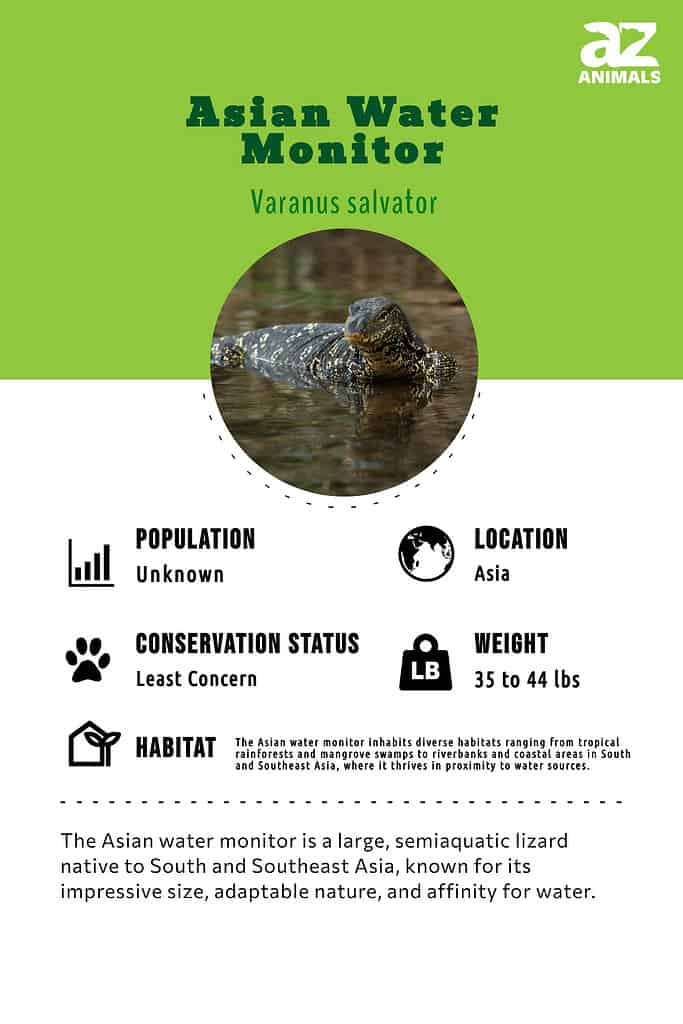
“The Asian water monitor is the second heaviest lizard in the world!”
Asian Water Monitor Interesting Facts
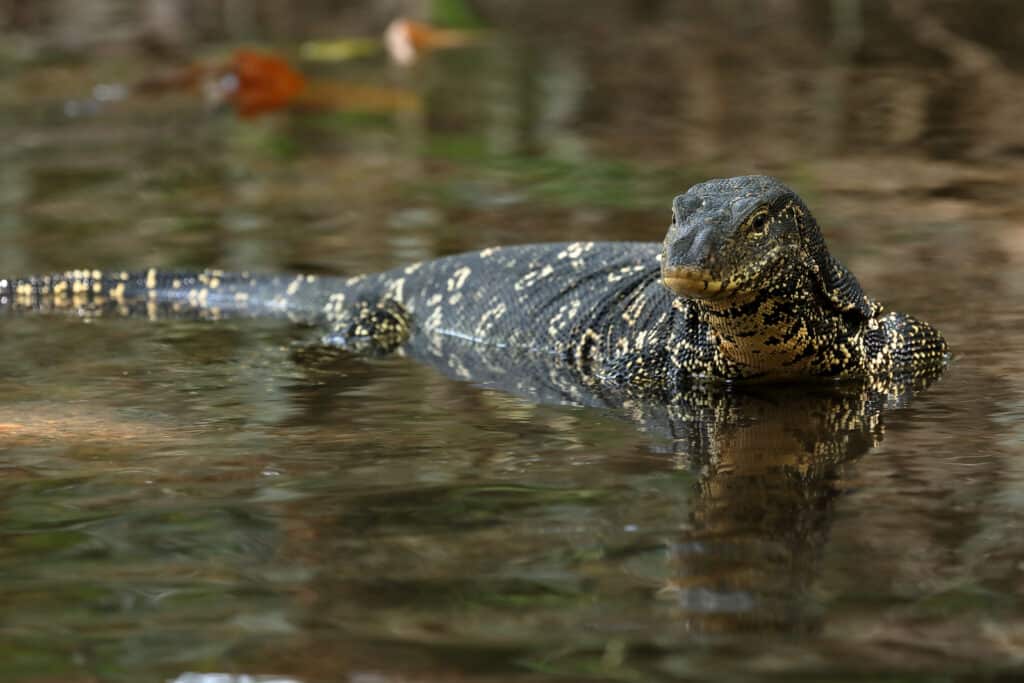
Due to their semiaquatic nature, the Asian water monitor displays a strong affinity for water and typically resides in close proximity to a water source at all times.
©iStock.com/heckepics
- A group of Asian water monitor lizards is called a lounge.
- They can be sustained on a wide range of food including small and medium-sized animals, discarded human food, and decaying flesh.
- These lizards commonly feast on dead human bodies, so their presence in an area might aid local authorities in looking for missing persons.
- As semiaquatic animals, the Asian water monitor is very fond of water and will always live close to a water source.
- It is the second heaviest and third longest lizard in the world!
- They are venomous, but their venom isn’t fatal or lethal to humans. You still don’t want these lizards to bite you, as their bite is strong enough to crush human bones!
Summary
Asian water monitors are one of the largest species of monitor lizards, second only to the Komodo dragon. This species is known for its powerful, muscular body, long tail, and yellow markings. They are versatile animals with a taste for decaying flesh. Asian water monitors are semiaquatic animals and spend a considerable amount of time in the water.
Evolution and Origins
Hailing from South and Southeast Asia, the water monitor (Varanus salvator) is a substantial lizard species. It is widely distributed across Asia, encompassing regions from Sri Lanka and India to Indochina, the Malay Peninsula, and numerous Indonesian islands. These monitors thrive in habitats in close proximity to water and are recognized as one of the prevalent types of monitor lizards in the region.
Water monitors possess remarkable adaptations for utilizing water, particularly as a means of evading predators. They exhibit a proclivity for exploring their surroundings by means of climbing, digging, and swimming between various locations. With their adept claws, they excel at scaling surfaces, while their tails serve as efficient paddles during aquatic maneuvers.
Scientific Names and Common Names
The scientific name of the Asian water monitor is Varanus salvator. The name Varanus comes from the Arabic word waral meaning “monitor,” while the name “salvatore” is the Latin word for “savior.” This suggests a possibility that this species might have some religious significance in its native region.
The Asian water monitor belongs to the biggest order of reptiles, Squamata, which comprises scaled reptiles, and over 10,900 living species. The water monitor belongs to the family Varanidae, just like the Komodo dragon, crocodile monitor, and savannah monitor.
The Asian water monitor is known by a host of other names such as Malayan water monitor, no-mark lizard, rice lizard, plain lizard, two-banded lizard, and ring lizard.
Many subspecies exist under the Asian water monitor umbrella. They can be found in many regions across the Asian continent.
Some of these are:
- Varanus salvator salvator can be found in Sri Lanka where it is called the kabaragova in Sinhala.
- Varanus Salvatore andamanensis is found in the Andaman Islands as its name suggests, as well as the southern Nicobar Islands.
- Varanus Salvatore ziegleri or Ziegler’s water monitor, inhabits Obi Island.
Appearance
The Asian water monitor is the second-heaviest lizard after the Komodo dragon. When fully mature, they weigh around 35 to 44 pounds and can reach great lengths of up to two meters long or six feet seven inches, about the size of a king-sized bed!
These monitor lizards have strong, scaled, muscular bodies with long tails that are laterally compressed. They possess long necks and long snouts. The scales on their head are notably larger than the ones on its back. A unique feature of these monitor lizards is their markings. They are typically dark brown or black with yellow spots located underneath. These yellow spots tend to fade over time as they age. They also have a distinctive black and yellow band stretching backward from each eye. These lizards have a formidable attack and defense system made up of powerful jaws, claws, and serrated teeth.
The largest Asian water monitor recorded was a 10.5-foot lizard from Sri Lanka.
Because Asian water monitors are semiaquatic animals, they are adapted to partial life in the water. They have a raised fin built into their tails for easy controlled navigation in water.
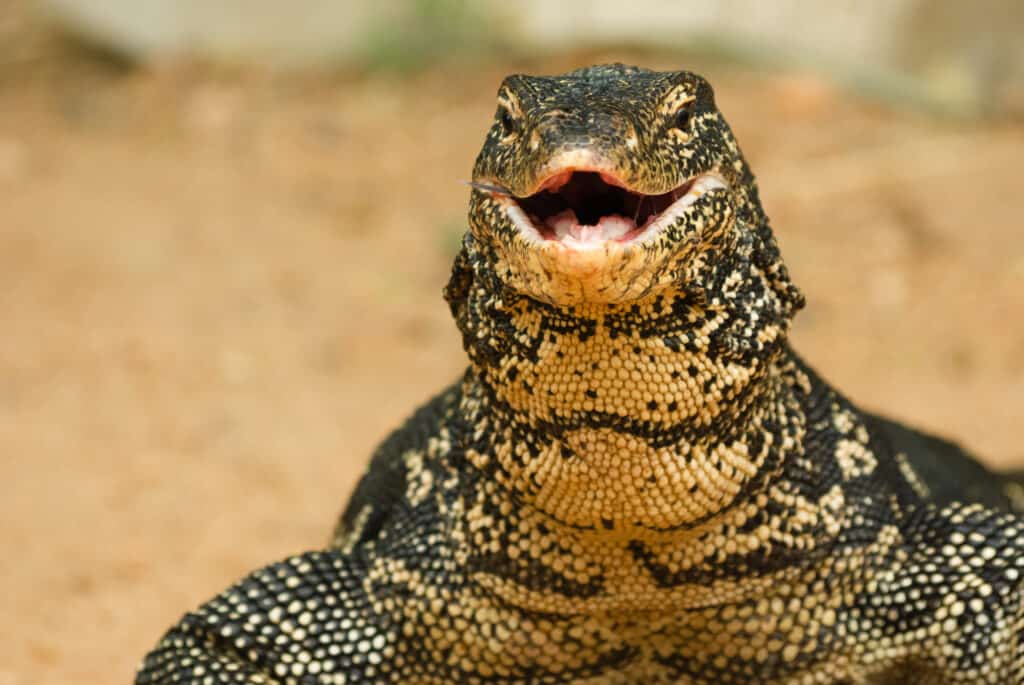
Asian water monitors have dark brown or black markings with yellow spots that fade as they age.
©iStock.com/Vidu Gunaratna
Behavior
These large lizards are known to be docile creatures, only attacking humans when provoked or threatened. Their strong jaws, sharp claws, and tails are their main weapons. When in attack mode, the Asian water monitor grabs its prey in its jaws and thrashes around to debilitate or kill it. The lizard then goes on to swallow the prey whole.
They are semiaquatic animals, thus, making them exceptional swimmers. They navigate bodies of water with the use of the raised fin on their tails. Being comfortable on land as well as in the water gives them a survival edge that land-only monitors don’t have. By finding refuge in the water, they gain further protection from predators who might not be water-savvy. Monitors are very versatile animals. In addition to water, they maneuver land masses as well. When threatened, they are known to climb trees to seek safety and can even jump from trees into streams.
Asian water monitors bite – they are venomous. However, their venom is not fatal to humans. The purpose of their venom hasn’t been fully ascertained yet, but it is believed to either help digest their food, herd off predators, or immobilize and kill prey. If you happen across this reptile, you’d do well to leave it alone and keep moving. Their venom may not be lethal, but their bite could seriously injure a person. They rarely attack humans, only doing so if they feel threatened or in danger.
Lifestyle
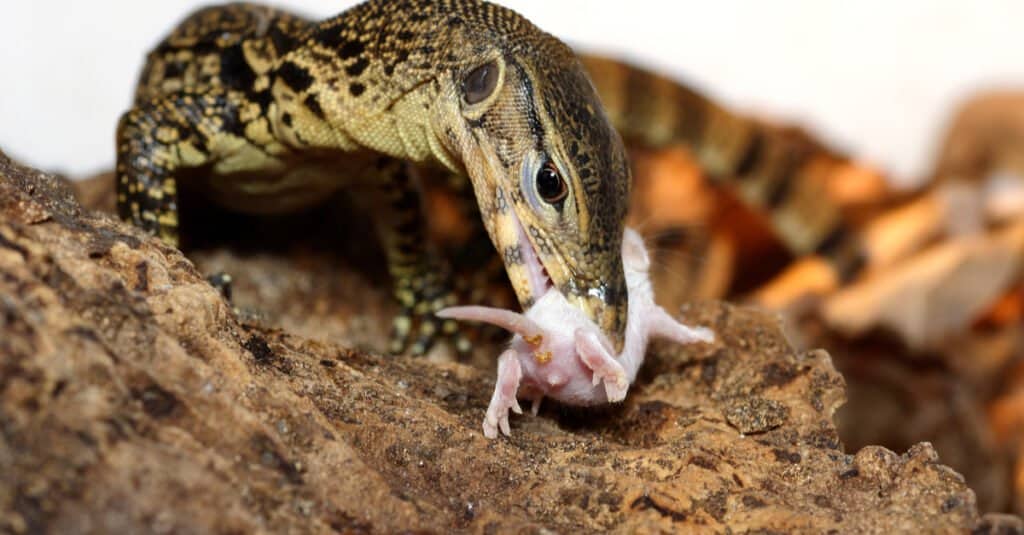
By nature, they are diurnal creatures, meaning they are most active during daylight hours and tend to rest or be less active during the nighttime.
©Valt Ahyppo/Shutterstock.com
They are diurnal by nature, active during the day, and restful at night. Sometimes the monitors will be active during the night, likely hunting prey, but for the most part, they rise and fall with the sun.
Asian water monitors are usually solitary animals. They will only band together in cases of resource competition, such as when water is limited. Water monitors are known to make friendly and affectionate pets when tamed, but they should only be handled by expert lizard keepers who have the knowledge and resources to properly care for these animals.
Habitat
This monitor lizard is prolific in Asia. It is native to south and southeast Asia and can be found in countries such as China, India, Indonesia, Vietnam, Sri Lanka, Myanmar, Thailand, Bangladesh, and Cambodia.
They are semiaquatic, and as such prefer to live in tropical regions that are readily accessible to water such as mangrove swamps and wetlands. They prefer areas with an elevation below 1,000 meters or 3,300 feet, although some of these monitor lizards have been recorded to reside in areas up to 5,900 feet. Additionally, their versatile mode of living allows them to dwell on human turf, living in agricultural regions, and even cities where they occupy canals. This is especially popular in Sri Lanka because they are not hunted there.
Population
They are a widely distributed animal geographically with footprints across Asia, from India, Indonesia, Singapore, Thailand, the Chinese provinces, Guangxi and Hainan, Sumatra, Java, and the Sunda islands. Its ecological flexibility enables it to occupy a wide range of regions and thrive in them.
In countries like Thailand, Nepal, and Hong Kong, this lizard is a protected species. In Sri Lanka, it is protected because it eats venomous snakes and crabs that disturb the rice field banks. It is largely hunted in India and has lost most of its habitat there, resulting in its rarity on the mainland. However, due to its wide distribution and ability to live in human-disturbed environments, it is listed as Least Concern on the IUCN Red List.
Reproduction and Lifespan
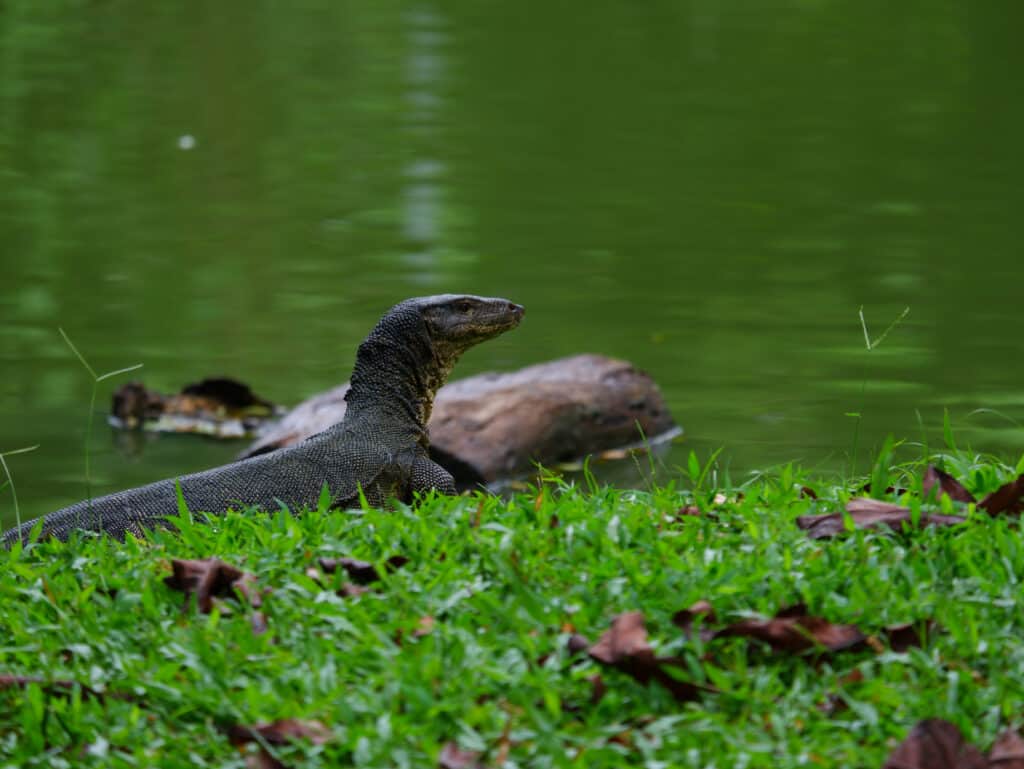
When kept in human captivity, the water monitor has a lifespan ranging from 11 to 25 years.
©MH Capture/Shutterstock.com
The high adaptability of this reptile helps it stay alive, giving it a decent lifespan. The water monitor can live from 11 to 25 years in human captivity, but in the wild, their lifespan is greatly reduced in comparison.
Asian water monitors are solitary animals that typically only come together during the breeding season which occurs from April to October. They are oviparous animals, which means that they lay eggs. Females usually lay their eggs in tree stumps or rotting logs.
Female monitors can lay anywhere from 10 to 40 eggs at a time. They incubate the eggs for a period of six to seven months. Hatchlings are precocious at birth, becoming independent as soon as they break out of their eggs.
It typically takes a couple of years for monitors to reach adulthood. You don’t need to do much to tell the males and females apart. The males grow to be almost twice as big as their female counterparts. The males reach sexual maturity at 3.3 feet long and just over two pounds and grow to be six to nine feet, while the females reach maturity at 20 inches or about 1.64 feet and reach lengths of up to five feet.
Diet
These are carnivorous animals that prey on fish, rodents, eggs, turtles, snakes, crabs, young crocodiles, and frogs. Lizards living in urban regions will also eat dogs, cats, chickens, birds, and human food scraps.
Water monitors are also scavengers, meaning they eat carrion or decaying meat. They can smell the carcasses of animals, including humans, from far distances.
Predators and Threats
They are fierce animals when it comes to attacking and defending themselves, and they can be evasive when fleeing from a threat. They do not have many natural predators, but saltwater crocodiles and King Cobras make the very short list.
Asian water monitors are hunted by humans for their skin, which is used to make leather for clothing items such as shoes, bags, and belts. Monitor skins are a sought-after source of leather, with a whopping 1.5 million skins traded each year!
In addition to fashion, water monitors are used as food in some parts of Asia, such as Indonesia and India. Some Indian tribes harvest the lizard’s skin, meat, fat, and even their eggs.
One of the biggest threats they face is the loss of their habitat when they are driven from it by communities who perceive them as pests.
Related Animals
View all 194 animals that start with AAsian Water Monitor FAQs (Frequently Asked Questions)
Are Asian water monitors dangerous?
Asian water monitors can be dangerous when provoked. They have an arsenal of weapons, including their powerful jaws, serrated teeth, sharp claws, and muscular tail. However, they are usually docile in nature and do not attack unless threatened.
Are Asian water monitors friendly?
Wild Asian water monitors are docile and do not attack humans, but that doesn’t mean they are eager for human contact. If you come across one living in the wild, do not try to approach it. However, they are known to be gentle and friendly creatures when tamed as pets.
Are Asian water monitors venomous?
Yes, Asian water monitors possess venom, but it is not fatal or dangerous to humans.
Are Asian water monitors poisonous?
Asian water monitors are not poisonous. As a matter of fact, they are hunted as food in many parts of Asia, and are considered a delicacy in some regions.
Are Asian water monitors a type of Komodo dragon?
Asian water monitors (Varanus salvator) and Komodo dragons (Varanus komodoensis) are two different species of the same genus, Varanus. They are both monitor lizards, but not the same species.
Are Asian water monitors good pets
Asian water monitors are said to make friendly, affectionate, and gentle pets once tamed, but only after much effort. It takes a dedicated lizard keeper with enough time and resources to keep a monitor lizard as a pet.
Do Asian water monitors attack humans?
Asian water monitors do not attack humans unless threatened. They do not kill humans because humans are not their natural prey.
What do Asian water monitors like to eat?
Asian water monitors hunt small and medium-sized animals such as frogs, rodents, young crocodiles, fish, and turtles. Asian water monitors that live in urban areas eat domesticated cats and dogs, human food waste, and chickens. These animals also eat decayed flesh of animals and humans.
How big are Asian water monitors?
Asian water monitors have been recorded to grow to over six feet long and weigh as much as 44 pounds. The longest Asian water monitor ever recorded was 10.5 feet long!
Has an Asian water monitor ever eaten a human?
Asian water monitors do not typically attack or kill humans, but they do eat rotting human flesh.
Can humans survive the bite of an Asian water monitor?
Asian water monitor bites are extremely painful because of their powerful jaws and serrated teeth. They are strong enough to crush human bones and they are venomous. These bites are not fatal, but the injured victim must be taken to the hospital immediately for treatment.
Thank you for reading! Have some feedback for us? Contact the AZ Animals editorial team.
Sources
- Wikipedia, Available here: https://en.wikipedia.org/wiki/Asian_water_monitor
- Thai National Parks, Available here: https://www.thainationalparks.com/species/varanus-salvator
- (1970)

















